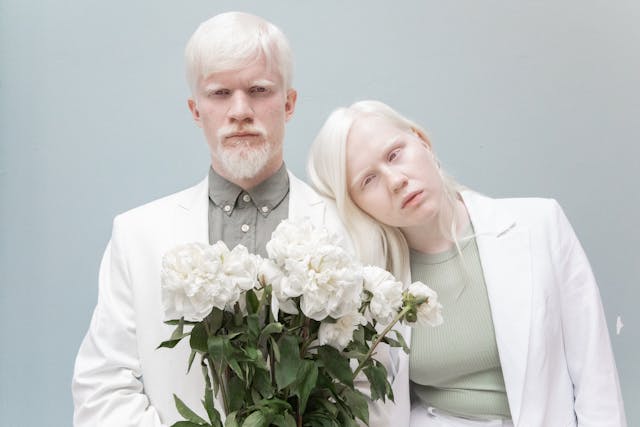
Why are some people albino? Some people are albino because they don’t produce melanin, which colors our bodies. However, any living thing that has color can be albino. The condition is called albinism.
Anything that has a color pigment can be albino if that pigment isn’t produced. You can get albino fish, insects, birds, mammals, and even plants. You don’t see many albino plants though, because they cannot survive. Albino people can obviously survive, so long as they take care in the sun. Although, that being said, cultures throughout history, and some that still exist, have thought that albino people have supernatural powers. Albino people were hunted and killed for their body parts. These body parts were used by witch doctors to make medicines. These days, that practice is dying out and heavily prosecuted, but it does still happen. Albino prey animals might have more trouble surviving than normal colored animals because they cannot hide due to lack of camouflage. Albino predators might also have trouble surviving because their prey will be able to see them coming. Albino plants cannot survive though because they need the green pigment chlorophyll to photosynthesize. Without that, they cannot make food, and the sunlight will damage them. They won’t last very long.
The color in the skin, hair, and eyes of most animals is made using some kind of pigment. A pigment is a chemical that reflects a certain wavelength of light. There are some animals that can change their color by adjusting the chemical, adjusting the concentration of the chemical, or by using mirrored scales. The majority of animals are stuck as the color they are born with. The pigment we have is called melanin, and there are two types. One is called eumelanin, and it is brown-black. The other is called pheomelanin, and it is red-yellow. Different quantities of each one of these will produce all of the different hair, eye, and skin colors we see in the world. Our bodies produce melanin in specialized cells called melanocyte,s and they constantly make and replenish it. One of the purposes of melanin is to protect us from sunlight, so you tend to get darker in the summer and lighter in the winter. This is caused by UV light. When your melanocytes are exposed to UV light, they produce more melanin. This is one reason why exposure to sunlight, particularly UV light, can cause skin cancer. The cells that are most likely to become cancerous are the ones that multiply quickly because there is more chance of a mutation appearing. If you are exposed to a lot of UV light, your melanocytes will reproduce more quickly, increasing your likelihood of skin cancer.
So, what causes albinism? There are several causes, but they all affect the genes that produce or distribute melanin. The most common type of albinism is called Oculocutaneous Albinism (OCA), and it happens when people have a defect in one or more of several genes. These people can’t produce melanin in their skin, hair, and eyes. There are different levels of this condition, and the strongest is called OCA1a. People who have this have absolutely no melani,n and they have white hair, very pale skin, and light eyes.
People who have albinism can suffer a lot of problems. Firstly, gene defects usually cause more than just one problem, and some types of albinism are brought about by syndromes that cause many other problems and even shorten life expectancy. However, even if someone does just have albinism, it will seriously affect their daily life. They will not be able to go out in strong sunlight without a lot of protection because they will burn. The melanin in our skin is there to stop the damage from UV light, and people with albinism don’t have this natural protection. They will also have trouble seeing outside because the melanin in our eyes doesn’t only give them color, it protects us from the harmful sun’s rays again. People with albinism will have very sensitive eyes. There is no cure for albinism at the moment.
In the future, gene therapy and gene editing may become a possibility. Even today, with CRISPR technologies, it is possible to edit genes and fix some damage. More therapies are appearing each year and soon there might be a cure for albinism. The problem is, albinism doesn’t affect enough people to make it one of the top priorities. Roughly 1 in 20,000 people have some form of albinism, and OCA1a only affects about 1 in 40,000 people. That is still a lot of people, but not enough to make finding a cure a top priority yet. And this is what I learned today.
Try these next
Sources
https://www.healthline.com/health/albinism#treatment
https://kidshealth.org/en/teens/albinism.html
https://www.mayoclinic.org/diseases-conditions/albinism/symptoms-causes/syc-20369184
https://en.wikipedia.org/wiki/Melanin
https://my.clevelandclinic.org/health/body/22615-melanin
https://www.gardeningknowhow.com/garden-how-to/info/albino-plant-information.htm
https://medlineplus.gov/genetics/condition/oculocutaneous-albinism/#causes
https://en.wikipedia.org/wiki/Persecution_of_people_with_albinism
Photo by Monstera Production: https://www.pexels.com/photo/expressive-albino-couple-with-bunch-in-studio-5273729/
